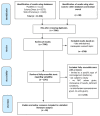Reduced Susceptibility and Increased Resistance of Bacteria against Disinfectants: A Systematic Review
- PMID: 34946151
- PMCID: PMC8706950
- DOI: 10.3390/microorganisms9122550
Reduced Susceptibility and Increased Resistance of Bacteria against Disinfectants: A Systematic Review
Abstract
Disinfectants are used to reduce the concentration of pathogenic microorganisms to a safe level and help to prevent the transmission of infectious diseases. However, bacteria have a tremendous ability to respond to chemical stress caused by biocides, where overuse and improper use of disinfectants can be reflected in a reduced susceptibility of microorganisms. This review aims to describe whether mutations and thus decreased susceptibility to disinfectants occur in bacteria during disinfectant exposure. A systematic literature review following PRISMA guidelines was conducted with the databases PubMed, Science Direct and Web of Science. For the final analysis, 28 sources that remained of interest were included. Articles describing reduced susceptibility or the resistance of bacteria against seven different disinfectants were identified. The important deviation of the minimum inhibitory concentration was observed in multiple studies for disinfectants based on triclosan and chlorhexidine. A reduced susceptibility to disinfectants and potentially related problems with antibiotic resistance in clinically important bacterial strains are increasing. Since the use of disinfectants in the community is rising, it is clear that reasonable use of available and effective disinfectants is needed. It is necessary to develop and adopt strategies to control disinfectant resistance.
Keywords: antimicrobial resistance; bacteria; disinfectants; susceptibility.
Conflict of interest statement
The authors declare no conflict of interest. The funders had no role in the design of the study; in the collection, analyses, or interpretation of data; in the writing of the manuscript, or in the decision to publish the results.
Figures
References
-
- ECHA Biocidal Products Regulation—Product Types. [(accessed on 10 February 2021)]; Available online: https://echa.europa.eu/regulations/biocidal-products-regulation/product-....
-
- Pohl K., Dulio V., Botta F., Schwarzbauer J., Rüdel H. Environmental monitoring of biocides in Europe: Compartment-specific strategies-Workshop report; Proceedings of the Environmental Monitoring of Biocides in Europe: Compartment-Specific strategies; Berlin, Germany. 25–26 June 2015.
Publication types
Grants and funding
LinkOut - more resources
Full Text Sources
Molecular Biology Databases


